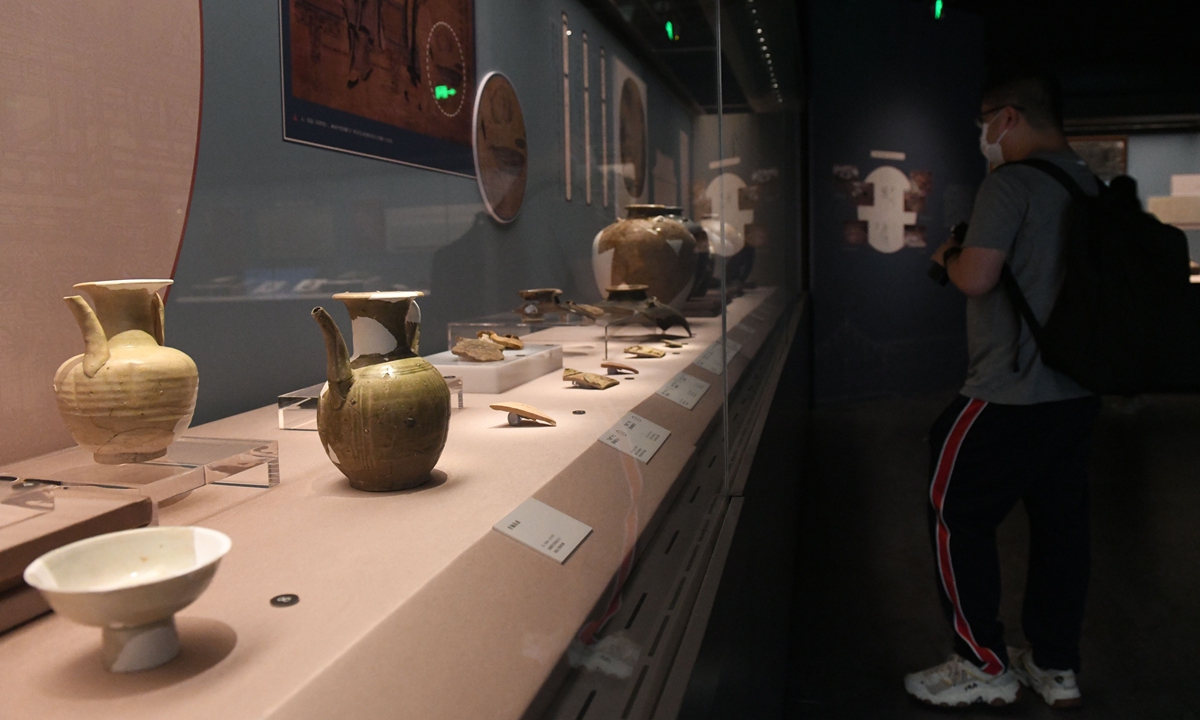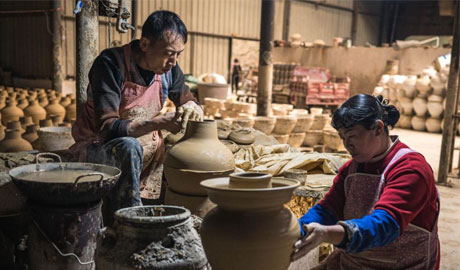


Exhibition featuring relics discovered from the the Nanhai No.1 shipwreck Photo: IC
Starting March 1, the revised Law on the Protection of Cultural Relics will be implemented nation-wide, introducing new regulations for cultural relic preservation and China's repatriation of lost arti-facts around the globe. A major focus of the updated law is to prioritize the protection of cultural rel-ics; and while the law has yet to take full effect, various regions in China have already begun imple-menting its principles.
On February 25, the Dongguan municipal government in South China's Guangdong Province held a press conference announcing the archaeological findings made at the Nanhaiwei City Wall site and a construction plan for an on-site archaeological park.
The plan includes halting a 200 million yuan ($27.4 million) urban renewal project in favor of preserving the 3,000-square-meter Nanhaiwei archaeological site. This area will be transformed into a heritage park, where the public can engage with its history and significance.
Located along Dongguan's Guancheng street, the Nanhaiwei City Wall site lies adjacent to the Ying'enmen City Tower, a provincial-level protected cultural heritage site. Covering about 15,000 square meters, the site descends approximately three meters underground and has yielded numerous artifacts that span the Song Dynasty (960-1279) to the Republic of China period (1912-1949). The excavations have uncovered architectural elements and daily objects, including 360 well-preserved small artifacts and 90 boxes of pottery shards.
According to a report from southcn.com, Dongguan, often dubbed the "world's factory," has made a bold move by halting a large-scale urban renewal project to prioritize the protection of archaeological sites. This shift signals a departure from the "GDP-first" mentality, demonstrating that historical and cultural heritage can be integral to urban development, not an obstacle.
Rather than simply sealing the site or burying it under layers of modern construction, the city has opted to create an archaeological park that will feature an exhibition area aimed to foster both public education and continue with archaeological work. The plan links the park to nearby historical districts, creating a cultural ecosystem that balances recreational and educational functions.
Huo Zhengxin, a law professor at the China University of Political Science and Law, told the Global Times on Thursday that the principle of "prioritizing the protection of cultural relics" plays a crucial role in the revised law. This also signifies a growing emphasis on preventive preservation.
"Under the revised law, land designated for construction must undergo archaeological surveys before development can proceed, and no construction can take place without first investigating the archaeological significance of a site," Huo said.
He also noted that Dongguan's on-site archaeological park initiative aligns perfectly with the updated law's goal of bringing cultural relics to life.
"Revitalizing historical districts and creating an archaeological display area serves to showcase relics as part of the city's public services, while enhancing the interpretation of their value. This ensures that social benefits take priority as long as relics are preserved securely," he said.
On February 15, the National Administration of Cultural Heritage convened a seminar in Xi'an, Northwest China's Shaanxi Province, to discuss revisions to the regulations for implementing the law, which emphasizes the importance of advancing the revision work for the implementation of the law.
In the wake of the new law's implementation, the fourth national cultural relics census has continued the work being carried out across China since 2023. The census aims to provide a comprehensive inventory of the country's cultural assets. Wang Hao, director of the Baoji Institute of Archaeology, told the Global Times that the Weizigou site and a 5,000-year-old small-mouthed, pointed-bottom amphora in Shaanxi were discovered during this census.
"This census provides a comprehensive baseline of cultural relics in the city of Baoji, including their quantity, distribution, and size, which is also part of the national territorial space plan. It allows for better protection of cultural heritage by ensuring that all relics that should be protected are indeed preserved," Wang said.
He further noted that the investigation into prehistoric relics and the identification of the scope and nature of relic sites in the region remain unclear. However, classifying sites as protected cultural relic sites will greatly help in determining the range of archaeological work.
In addition to the census, cities like Zhengzhou in Central China's Henan Province are making strides to make archaeological findings more accessible to the public, while sites such as the Site of Bashbaliq in Northwest China's Xinjiang Uygur Autonomous Region are developing archaeological parks to promote the dual goals of preservation and public engagement.
"With the implementation of the new law, there will be an overall modification and improvement to the system of relic protection, as well as further initiatives such as exhibitions and cultural creative activities to help the public better understand cultural relics and their connection to culture," Huo said.

Xinjiang launches consumption voucher program to boost winter tourism

Liaohu Village of China's Yunnan boasts thousand-year pottery-making tradition

Yading scenic spot in China's Sichuan in best viewing season

Internet life carnival kicks off in Tongxiang City, China's Zhejiang

In pics: drifting ice in Jiayin section of China's Heilongjiang River
点击右上角![]() 微信好友
微信好友
 朋友圈
朋友圈

请使用浏览器分享功能进行分享
